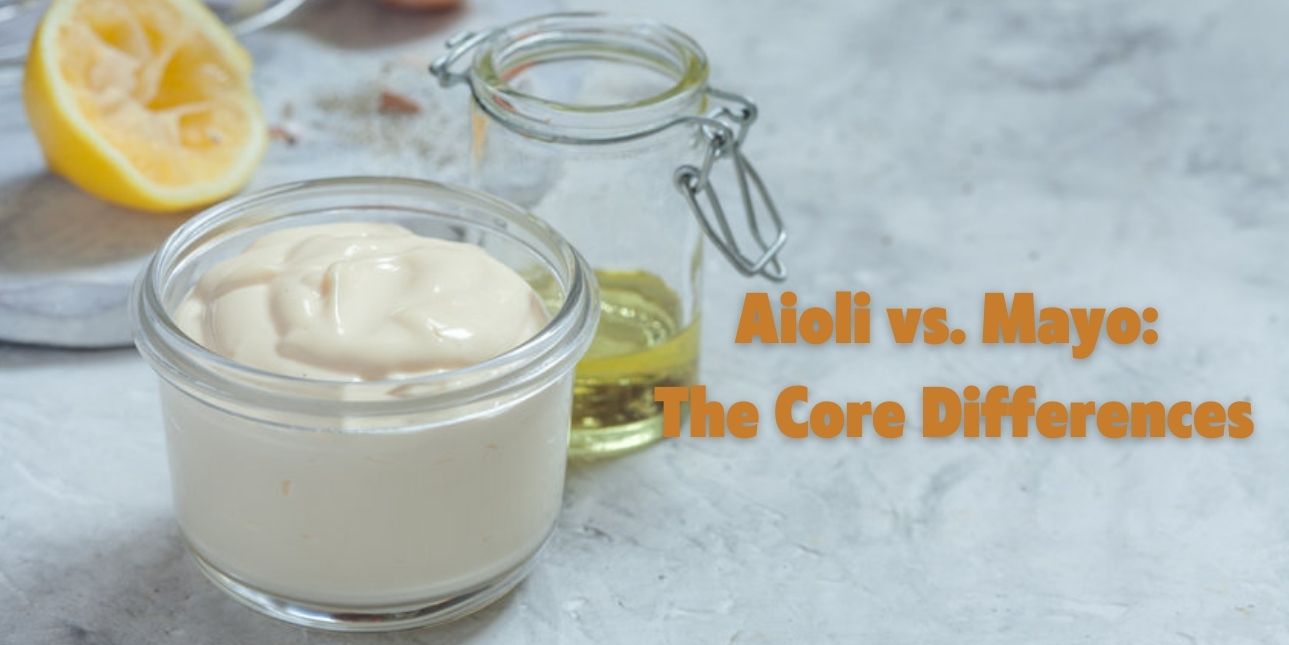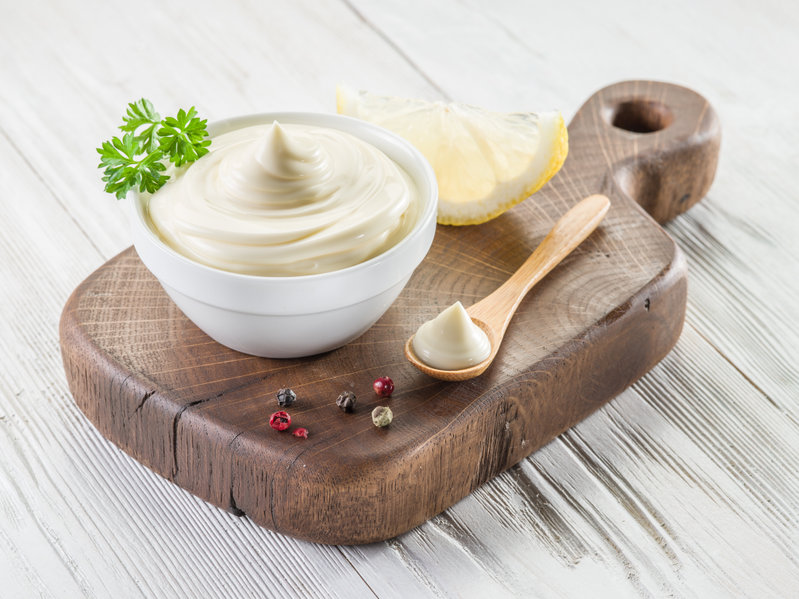
If you serve various appetizers in your restaurant or foodservice establishment, a diverse platter of sauces or dips is imperative. Mayo and aioli are both great sauces that delicious appetizers can accompany. Most restaurants worldwide serve mayo or aioli, but it is hard to distinguish between the two due to their visual similarities. But taste-wise, both mayonnaise and aioli are distinct. As mayo primarily contains egg yolks and canola oil, aioli is made from garlic and olive oil.
In this article, we discuss the primary differences between mayonnaise and aioli, what mayonnaise is, how to make mayonnaise, the health benefits of mayonnaise, what aioli is, the process of emulsification, how to make aioli, different types of aioli, and the health benefits of aioli.
What is the Difference Between Mayonnaise And Aioli?
There are some similarities between aioli and mayo because both have a creamy texture. The primary difference between mayonnaise and aioli is that aioli is made from olive oil and garlic. On the other hand, mayonnaise is made from canola oil and egg yolks. These two sauces have distinct flavors, and they can accompany various appetizers and dishes.
Some Other Differences Between Aioli and Mayo
There are other differences between aioli and mayo; you can also make mayonnaise with olive oil instead of canola oil. You can also use egg yolks while preparing aioli, which makes it similar to mayonnaise. Additionally, some mayo and aioli preparations contain natural flavors or ingredients, making it extremely difficult to distinguish between mayo and aioli.
What is Mayonnaise?
Mayonnaise is a popular thick and cold sauce used in the preparation of sandwiches, burgers, pizzas, sauces, and other dips. More common than aioli, you can blend and prepare mayonnaise with various ingredients, including even mint to make mint mayonnaise! Similar to aioli, mayo is also made by following an emulsification process. The main differences between aioli vs. mayonnaise lie in the various ingredients that are used for making them.
How to Make Mayonnaise?
There are different processes that you can follow to make mayonnaise. he main steps to make mayonnaise are as follows:
- Add canola oil with egg yolk, and whisk the ingredients consistently to obtain a smooth texture.
- Canola oil creates a creamy white texture when mixed with egg yolks.
- Egg yolks have lecithin that makes the super-smooth texture that mayonnaise is known for.
- After the egg yolk and oil have blended, add some lemon or lime juice to it.
- You can also use vinegar instead of lemon juice or lime juice.
- Add some table salt to the blend depending upon your taste.
- Whisk all the ingredients consistently during the process.
- You can also add some black pepper and mustard to give it a twist.
Freshly prepared mayo can last for a maximum of 3 to 4 days in the refrigerator. However, store-bought mayonnaise can last for months as they contain preservatives. Professional chefs around the world prepare their mayonnaise according to their version of the above recipe.
Health Benefits of Mayonnaise
Most people assume mayonnaise is unhealthy for the body. To the contrary, consuming some mayonnaise regularly can help your body absorb Vitamin A, D, E, and K. Mayonnaise contains eggs and canola oil which helps in boosting the immunity system if consumed in moderation.
Mayonnaise is a perfect accompaniment that can be served with multitudes of dishes. You can serve mayonnaise with chicken wings, meatballs, and onion rings. You can even use mayo in salads, subs, and sandwiches as per your requirements. Additionally, mayo also works perfectly as a base for pizza and pasta.
What is Aioli?
The word ‘aioli’ means garlic oil in Spanish. Some say that aioli originated in Catalonia in Spain. Over the years, the popularity of aioli has encompassed multiple continents. Aioli is served across North America, Europe, and Asia along with various types of appetizers. You can also use aioli in freshly made salads, subs, and sandwiches.
Aioli is primarily a thick sauce with garlic, and it goes through an emulsification process during its production. It is quite similar to mayo in texture as both are made from an emulsification process.
Process of Emulsification
The emulsification process involves mixing or blending two or more ingredients that do not blend easily. Aioli is naturally made from garlic and olive oil, its primary ingredients. You can also add some salt depending on your requirements. To keep all the ingredients and the emulsified end product at ideal temperatures, you can purchase high-quality commercial refrigerators for your foodservice establishment.
How to Make Aioli?
Aioli is easy to make, but you need to follow a few steps to attain perfection:
- Firstly, mash some garlic cloves to a perfect paste.
- You can use a mortar and pestle to create the paste.
- While mashing the garlic, you can add virgin olive oil or extra virgin olive oil.
- Add egg yolks to the mix along with lemon or lime juice.
- Egg yolks are perfect emulsifiers, but most chefs make aioli without eggs.
- However, adding an emulsifier will bind the ingredients perfectly.
- After preparing aioli, you can use commercial refrigerators to refrigerate it. Freshly made aioli can be consumed within 3 to 4 days.
Different Types of Aioli
Aioli and mayo are available in various flavors. You can make chipotle-based aioli, truffle oil-based aioli, sriracha-based aioli, and mustard-based aioli, depending upon your requirements. Indeed, you can add multitudes of natural ingredients to obtain different types of aioli.
Health Benefits of Aioli
Aioli is good for health if consumed in moderation. As aioli contains olive oil and garlic, both these ingredients can help in improving the immune system. Some amount of aioli daily can be a good source of Vitamin E and Omega 3, which is great for lowering cholesterol levels and helps in fighting cancer.
You can use aioli as dips or sauces for various dishes. You can serve aioli with cheese balls, potato wedges, and roasted potatoes. You can also serve aioli with grilled chicken, meat, or seafood. Additionally, you can make delicious and healthy salads with aioli.
Mayo vs. Aioli: The Final Verdict
The differences between aioli and mayo can make your life difficult in the kitchen. Most patrons think that a garlic-flavored mayo is aioli, which is incorrect. It is also frequently assumed that all pale-colored off-white creamy textures are mayo, which is not true either. Mostly, aioli tastes different due to its garlic and virgin olive oil content. Restaurants serve real aioli and garlic-mayonnaise interchangeably depending upon availability. Chefs prefer both these condiments depending upon the appetizer they are served with. When aioli vs. mayonnaise are placed beside each other, it’s challenging for an untrained eye or taste palette to find the differences between the two.
In conclusion,it does not matter whether you are serving aioli or mayonnaise as both these sauces taste great with the right type of dish. You can serve them with cheese balls, meatballs, french fries, and chicken wings. Both aioli and mayo are perfect for cafes, diners, restaurants, and fast-food joints.










